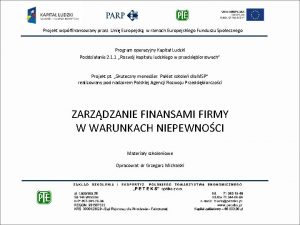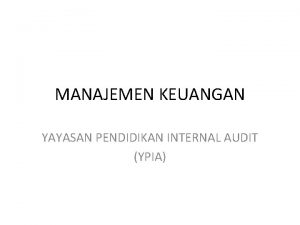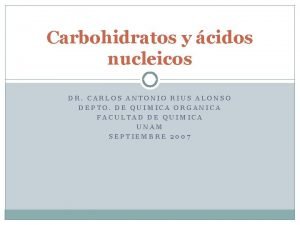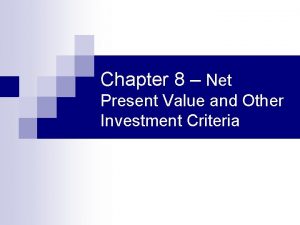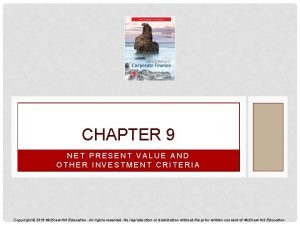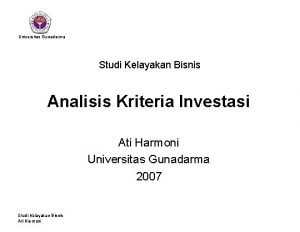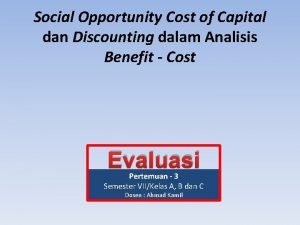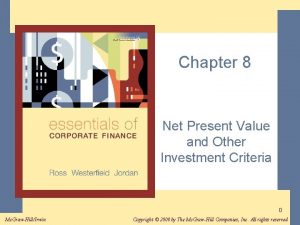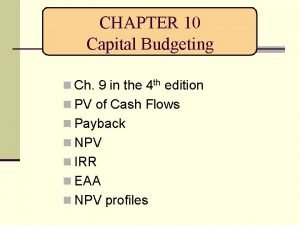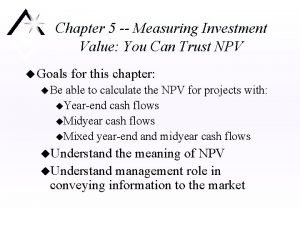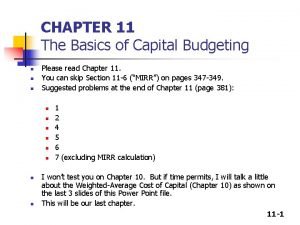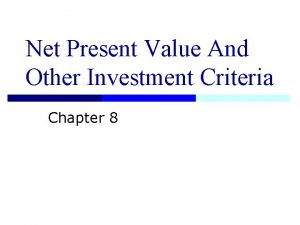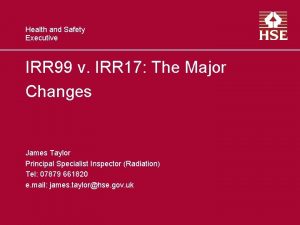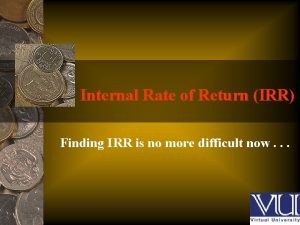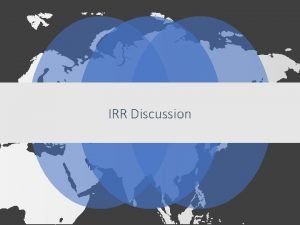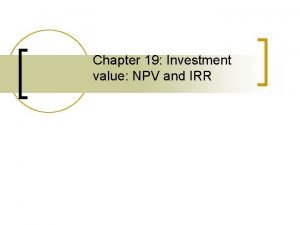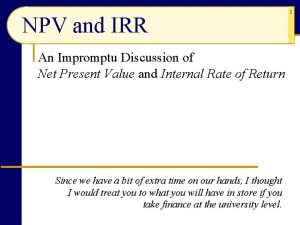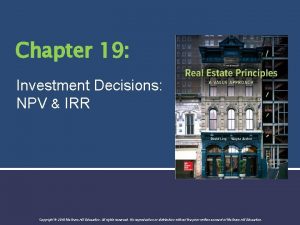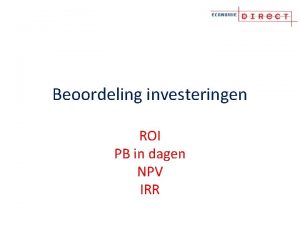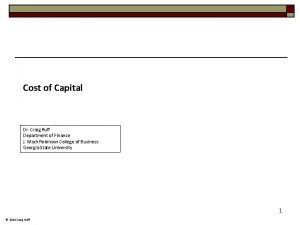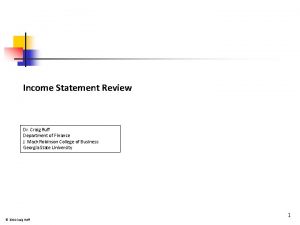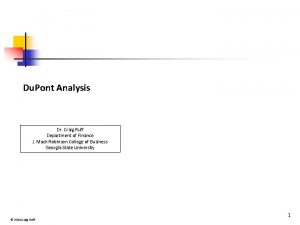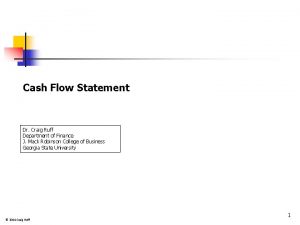NPV Vs IRR Dr Craig Ruff Department of
































- Slides: 32

NPV Vs. IRR Dr. Craig Ruff Department of Finance J. Mack Robinson College of Business Georgia State University © 2014 Craig Ruff 1

NPV Vs. IRR Recall our project: A company is considering building a polyethylene plant in Alpharetta, Georgia, USA Year Net Cash Flows t=0 -$2, 000 t=1 $1, 000 t=2 $800 t=3 $600 t=4 $200 We estimate that it will cost $2000 to build the plant and result in these positive net cash flows over the next 4 year. 2

NPV Vs. IRR NPV 3

NPV Vs. IRR 4

NPV Vs. IRR For a single project, NPV and IRR will always give the same accept/reject decision If NPV > 0 IRR > Cost of Capital If NPV < 0 IRR < Cost of Capital 5

NPV Vs. IRR One way to see this is to suppose the cost of capital is 14. 47%. Since the IRR of 14. 48% is the rate that makes the NPV = 0, then using the lower rate of 14. 47% to discount the cash flows would have to make the NPV positive. So, in this case, we would see both … NPV: accept because the NPV > 0 and IRR: accept because the IRR > Cost of Capital (14. 48 > 14. 47). 6

NPV Vs. IRR Now, suppose the cost of capital is 14. 49%. Since the IRR of 14. 48% is the rate that makes the NPV = 0, then using the higher rate of 14. 49% to discount the cash flows would have to make the NPV negative. So, in this case, we would see both … NPV: reject because the NPV < 0 and IRR: reject because the IRR < Cost of Capital (14. 48 < 14. 49). 7

NPV Vs. IRR For a single project, NPV and IRR will always give the same accept/reject decision Remember that the IRR is the rate that makes the NPV = 0. If NPV > 0 IRR > Cost of Capital If NPV < 0 IRR < Cost of Capital NPV at a Cost of Capital of 14. 47% = $. 61 NPV at a Cost of Capital of 14. 49% = -$. 379 8

NPV Vs. IRR But NPV and IRR may rank projects differently…. If one method accepts (green), then the other method will accept. If one method rejects (red), then the other method will reject. The point is that the two methods can rank the projects differently. 9

NPV Vs. IRR Arguably, if a firm has unlimited capital and employee resources, it should take on all positive NPV (or, IRR>WACC) projects. That would maximize shareholder wealth. But what if the firm does not have enough money or managerial talent to take on all of the good projects? Or, suppose two factories are being proposed for one piece of land. If you build one factory, you cannot build the other. This creates a situation of having mutually exclusive projects – if the company goes forward with one (or more) of the potential projects, it cannot take on the other(s). 10

NPV Vs. IRR With mutually exclusive projects, the difference is ranking becomes critical. Should the company go by NPV’s ranking or IRR’s ranking in selecting which projects to move forward with? 11

NPV Vs. IRR To put some numbers to the ranking differences of the two methods (NPV and IRR), let’s introduce another simple example for the same company that was considering the Alpharetta project. Assume the appropriate cost of capital is 10% for both projects. Assume that the company only has enough managerial talent to proceed with one of these projects. Project: Roswell Factory Year Net Cash Flows t=0 -$2, 000 t=1 $200 t=2 $600 t=3 $800 t=4 $1200 Payback Period? = 3. 33 NPV? = 98. 35 IRR? = 11. 79% 12

NPV Vs. IRR Comparing the Roswell Factory to the Alpharetta Factory… Project: Roswell Factory Project: Alpharetta Factory Payback Period? = 3. 33 Payback Period? = 2. 33 NPV? = 98. 35 NPV? = 157. 63 IRR? = 11. 79% IRR? = 14. 48% In this case, the Alpharetta factory dominates the Roswell factory in terms of both NPV and IRR. 13

NPV Vs. IRR But what if the Cost of Capital is 5% (as opposed to 10%)? Note that the payback period and IRR numbers will not change with the change in the cost of capital from 10% to 5% 14

NPV Vs. IRR Comparing the Roswell Factory to the Alpharetta Factory using a 5% cost of capital (as opposed to 10%) Project: Roswell Factory Project: Alpharetta Factory Payback Period? = 3. 33 Payback Period? = 2. 33 NPV? = 413. 00 NPV? = 360. 84 IRR? = 11. 79% IRR? = 14. 48% In this case, the IRR approach would pick the Alpharetta factory, and the NPV approach would select the Roswell factory. 15

NPV Vs. IRR First, why did NPV and IRR agree at a cost of capital of 10% but disagree at a cost of capital of 5%? Let’s consider the cash flows of the two projects. Project: Roswell Factory Project: Alpharetta Factory Year Net Cash Flows t=0 -$2, 000 t=1 $200 t=1 $1, 000 t=2 $600 t=2 $800 t=3 $600 t=4 $1200 t=4 $200 16

NPV Vs. IRR This chart contains the NPVs for the two projects using different costs of capital. On the next slide are the graphs of these numbers. Cost of Capital Alpharetta Roswell 0% $600 $800 1% $549 $716 2% $499 $635 3% $452 $558 4% $406 $484 5% $361 $413 6% $318 $345 7% $276 $279 7% $267 8% $235 $217 9% $196 $156 10% $158 $98 11% $121 $43 12% $85 ($11) 13% $50 ($63) 14% $16 ($112) 15% ($17) ($160) 16% ($49) ($206) 17% ($80) ($251) 18% ($110) ($294) 17

NPV Vs. IRR We call these graphs the NPV Profiles. 18

NPV Vs. IRR We call these graphs the NPV Profiles. IRR Roswell IRR Alpharetta 19

NPV Vs. IRR We call these graphs the NPV Profiles. 20

NPV Vs. IRR We call these graphs the NPV Profiles. 21

NPV Vs. IRR We call these graphs the NPV Profiles. Crossover rate = 7. 2% 22

NPV Vs. IRR Crossover rate = 7. 2% To sum up, we see that if the cost of capital is greater than the crossover rate (7. 2%), then Alpharetta will have the higher NPV. If the cost of capital is less than the crossover rate (7. 2%), then Roswell will have the higher NPV. But IRR likes Alpharetta. Why did this occur? 23

NPV Vs. IRR When do we typically have differences in the results from the two approaches? • Projects differ in terms of timing (which we see with the Alpharetta factory versus the Roswell factory) • Projects differ in terms of size Two Mutually Exclusive Projects (assume cost of capital = 10%) Project S: IRR: 56% NPV: $23 million Project L: IRR: 15% NPV: $446 million 24

NPV Vs. IRR What should we do if IRR and NPV disagree about which of these two mutually exclusive projects is the better one? In general, the standard classroom answer is that we should go with the NPV results. Why NPV over IRR? One reason is that NPV focuses on which project will add the most to shareholder wealth, which is the goal of the firm. Also, NPV uses the more reasonable reinvestment assumption. Recall that NPV assumes reinvestment at the cost of capital and IRR at the IRR. Also, there is the possibility of multiple IRRs. This can occur if there are multiple sign changes in the cash flows. 25

NPV Vs. IRR Summary of NPV vs. IRR… The NPV and IRR metrics are very similar. The key differences are: • NPV focuses on a project’s addition to shareholder wealth and assumes reinvestment at the cost of capital (WACC). • IRR focuses on the project’s return and assumes reinvestment at the project’s IRR. 26

Internal Rate of Return Summary of NPV vs. IRR… The IRR calculation makes the following assumptions: 1) It gets the cash flows as expected 2) It can reinvest the intermediate cash flows at the IRR 3) It stays in the investment as long as planned. © 2014 Craig Ruff The NPV calculation has a similar set of assumptions: 1) It gets the cash flows as expected 2) It can reinvest the intermediate cash flows at the cost of capital 3) It stays in the investment as long as planned. 27

NPV Vs. IRR Summary of NPV vs. IRR… For an individual project, IRR and NPV will always yield the same accept/reject decision. If NPV accepts a project, IRR will accept the project, and vice versa. If NPV rejects a project, IRR will reject the project, and vice versa. 28

NPV Vs. IRR Summary of NPV vs. IRR… However, IRR and NPV may not always rank a set of projects in the same way: What types of projects may have different rankings by PV and IRR? - Projects differ in terms of timing - Projects differ in term of size 29

NPV Vs. IRR Summary of NPV vs. IRR… The differences in ranking matter if the company has mutually exclusive projects, which can result from: 1) The company has constrained capital. Ideally, the company should take on all projects with positive NPVs (or IRRs > WACC); however, the company may have a limited amount of capital, which means that the company has to choose between ‘good’ projects. 2) The projects may be physically mutually exclusive. For instance, suppose the company is considering two proposed factories for one piece of land. Since only one factory can be built, building one factory precludes the other. Or, perhaps the company has a limited amount of managerial talent to run the full set of projects. 30

NPV Vs. IRR Summary of NPV vs. IRR… Academics like NPV rankings better because: • NPV makes the more reasonable assumption about the reinvestment rate. IRR assumes company can reinvest intermediate cash flows at the project’s IRR? NPV assumes that the company can reinvest at the average cost of capital (WACC). • NPV focuses on additions to shareholder wealth. A small high-return project may not add as much shareholder wealth as a larger not-ashigh-return project. • It is possible to have multiple IRRs for one project. 31

NPV Vs. IRR Summary of NPV vs. IRR… Source: ” How Do CFOs Make Capital Budgeting and Capital Structure Decisions, ” Graham and Harvey, Journal of Applied Corporate Finance, Volume 15, Number 1, Spring 2002
 Why do irr and npv rank the two projects differently?
Why do irr and npv rank the two projects differently? Przeplywy finansowe
Przeplywy finansowe Manajemen keuangan yayasan
Manajemen keuangan yayasan Cross-ruff coupon
Cross-ruff coupon Ejemplos de carbohidratos reductores
Ejemplos de carbohidratos reductores Cross ruff sampling
Cross ruff sampling Ejemplos de azucares reductores
Ejemplos de azucares reductores Nicolas ruff
Nicolas ruff Cross ruff coupon
Cross ruff coupon Nicolas ruff
Nicolas ruff Degradacion de ruff
Degradacion de ruff Contoh kasus keputusan investasi
Contoh kasus keputusan investasi Sensitivity specificity ppv npv
Sensitivity specificity ppv npv Npv real estate
Npv real estate Payback chapter 8
Payback chapter 8 Npv method of project evaluation
Npv method of project evaluation Advantages of capital budgeting
Advantages of capital budgeting Npv profiles
Npv profiles Tabel npv
Tabel npv Npv irr矛盾
Npv irr矛盾 Irr decision rule
Irr decision rule Rumus opportunity cost
Rumus opportunity cost Npv meaning
Npv meaning Payback chapter 8
Payback chapter 8 What is international capital budgeting
What is international capital budgeting Project alpha's npv profile crosses the vertical
Project alpha's npv profile crosses the vertical Npv meaning
Npv meaning Decision tree analysis in capital budgeting
Decision tree analysis in capital budgeting What is the basic npv capital budgeting formula?
What is the basic npv capital budgeting formula? Profitability index ba ii plus
Profitability index ba ii plus Sampa video inc case solution
Sampa video inc case solution Profitability index formula
Profitability index formula Mirr method
Mirr method

